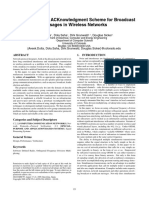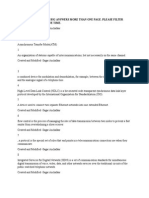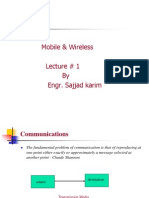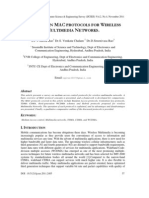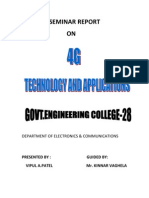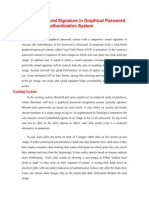Data Comp
Data Comp
Uploaded by
Anjeche TomCopyright:
Available Formats
Data Comp
Data Comp
Uploaded by
Anjeche TomCopyright
Available Formats
Share this document
Did you find this document useful?
Is this content inappropriate?
Copyright:
Available Formats
Data Comp
Data Comp
Uploaded by
Anjeche TomCopyright:
Available Formats
UNIT NAME: INTRODUCTION TO DATA COMMUNICATION & COMPUTER
NETWORKS
UNIT CODE: BIT 2204
NAME: Anjeche Makhaso Tom
ADMN NO: BIT/2022/54681
Describe the Various techniques used for analog-to-digital conversion. (2 marks)
Successive Approximation
Analog to digital conversion iteratively approximates the analog value by successively
dividing the reference voltage and comparing the input analog signal with a reference
voltage. When the digital value closely resembles the analog input, it starts with the most
significant bit (MSB) and moves on to the least significant bit (LSB).
Sigma-Delta technique
A sigma delta converts analog signal into high resolution and low noise. A sigma delta converts
an analog signal into high frequency digital stream by oversampling and using a delta sigma
modulator. The digital stream is then filtered an decimated to obtain the final digital
What is multiplexing in the context of data communication? (1 mark)
Is the process where multiple analog message signals or digital data streams are
combined into one signal over a shared medium. The aim is to share an expensive
resource.
Discuss the different types of multiplexing techniques used in data communication. Compare and
contrast their advantages and disadvantages (4 marks)
Frequency division multiplexing(FDM)
Is as a type of multiplexing where the bandwidth of a single physical medium is divided into a
number of smaller, independent frequency channels.
Time division multiplexing(TDM)
Is a type of multiplexing where in FDM, instead of sharing a portion of the bandwidth in the
form of channels, in TDM, time is shared. Each connection occupies a portion of time in the
link.
Advantages
Efficient use of resources: Multiplexing enables the transmission or processing of several signals
or data streams via a single shared media or channel.
Cost effective: Multiplexing decreases the demand on specialised resources and equipment by
combining multiple signals or data streams.
Disadvantages
Limited flexibility: Comparing multiplexing approaches to dedicated channels or point-to-point
connections may result in a reduction in flexibility.
Difficulty in signal isolation: It can be difficult to isolate and separate distinct signals at the
receiving end in some multiplexing techniques, such as frequency-division multiplexing (FDM)
or wavelength-division multiplexing (WDM).
Enable the efficient transmission of diverse types of information?
(3 marks)
Compatibility and interconnectivity: The integration of diverse signals or data streams is
made easier by multiplexing techniques, which encourages system and device compatibility
and interconnectivity.
Scalability and adaptability: Techniques for multiplexing provide scalability and adaptability
to handle changing requirements or the addition of new information forms.
Flexibility in signal allocation: When it comes to distributing resources to various forms of
information, multiplexing offers flexibility.
What is modulation and demodulation in the context of data communication? Explain the
purpose and importance of the two concepts in transmitting data over communication channels.
Modulation –is the process by which data/information is converted into electrical/digital
signals for transferring that signal over a medium
Demodulation- is the process of extracting the original information-carrying signal from a
modulated carrier wave. (2
marks)
Discuss the different types of modulation techniques used in data communication. (4 marks)
Amplitude Modulation(AM)
In AM, the amplitude of the carrier signal is varied in proportion to the instantaneous amplitude
of the modulating signal.
Frequency Modulation(FM)
FM involves changing the carrier signal's frequency to match the modulating signal.
Phase Modulation(PM)
It involves varying the phase of the carrier signal in response to the modulating signal.
Quadrature Amplitude Modulation(QAM)
It allows the simultaneous transmission of amplitude and phase data.
ii) Discuss the role of modulation and demodulation in wireless communication systems. How do
these techniques enable reliable transmission of data over wireless channels? (2 marks)
Modulation prepares the information for transmission, optimizing bandwidth usage,
improving signal integrity, and enabling long-range communication. Demodulation at the
receiver's end extracts the original information from the modulated signal, facilitates error
detection and correction, reduces noise effects, and enables the proper interpretation and
utilization of the received data.
iii) Discuss the advancements in modulation and demodulation techniques in recent years.
Explore any emerging modulation technologies and their potential applications in data
communication. (2 marks)
• They support increased data speeds, better spectrum utilisation, and improved fading and
interference resistance. Because of this, cutting-edge modulation techniques like FBMC, NOMA,
and PDM have a bright future as applications in 5G/6G networks, the Internet of Things, smart
grids, and immersive multimedia experiences.
What is Ethernet? Explain its history, development, and its significance as a widely used
networking technology. Elaborate on the different versions of Ethernet, starting from the original
Ethernet specification to the more recent standards (4 marks)
Ethernet: is a standard communications protocol used to connect devices including
computers, routers, and switches in a wired or wireless network.
HISTORY
It was invented by Robert Metcalfe and David Boggs at Xerox PARC in 1973. It first ran at just
under 3 Mbps. Metcalfe joined Digital Equipment Corporation where he facilitated a joint
venture with Intel and Xerox to collaborate further, and Ethernet Version 1 was finalized in
1980. In 1983, the Institute of Electrical and Electronics Engineers (IEEE) approved the Ethernet
802.3 standard.
i)Discuss the concept of Ethernet collision detection and collision avoidance mechanisms,
such as CSMA/CD (Carrier Sense Multiple Access with Collision Detection). Explain how
these mechanisms help manage network traffic and prevent data collisions (3 marks)
CSMA/CD is widely used in Ethernet networks, especially in legacy systems based on
the IEEE 802.3 standard. However, with the evolution of Ethernet technology, including
the deployment of full-duplex switches and the widespread use of twisted pair cabling,
CSMA/CD is less commonly used in modern Ethernet networks. Full-duplex
communication allows simultaneous transmission and reception, eliminating the need for
collision detection.
ii) Explain the role of switches in Ethernet networks. Discuss how switches facilitate
efficient data transmission, reduce collisions, and improve network performance. (3
marks)
• By splitting the network into separate collision areas, selectively forwarding frames based on
MAC addresses, providing full-duplex communication, and optimising bandwidth usage,
switches in Ethernet networks enhance network performance. Switches improve the
effectiveness, dependability, and throughput of data transmission in Ethernet networks by
eliminating collisions, reducing unneeded network traffic, and giving dedicated bandwidth to
each device.
REFRENCES:
www.w3schools.com
www.tutorialspoint.com
www.wikipedia.com
You might also like
- Concise Guide to OTN optical transport networksFrom EverandConcise Guide to OTN optical transport networksRating: 4 out of 5 stars4/5 (2)
- A Summer Training Report NetworkingDocument44 pagesA Summer Training Report NetworkingMuditSinghChoudharyNo ratings yet
- Simulation of Digital Communication Systems Using MatlabFrom EverandSimulation of Digital Communication Systems Using MatlabRating: 3.5 out of 5 stars3.5/5 (22)
- Common Principles of Couple Therapy 2012 Behavior TherapyDocument11 pagesCommon Principles of Couple Therapy 2012 Behavior TherapyAleexandra SuarezNo ratings yet
- Brief Description of The PHYSICAL LAYER of The TCP/IP ArchitectureDocument8 pagesBrief Description of The PHYSICAL LAYER of The TCP/IP ArchitectureNishanth PrakashNo ratings yet
- Digital Cross Connect Systems (DCS) - A TechnologySurvey, Key Challenges, Architectures and ApplicationsDocument9 pagesDigital Cross Connect Systems (DCS) - A TechnologySurvey, Key Challenges, Architectures and Applicationsaman lakherwalNo ratings yet
- Smack - A Smart Acknowledgment Scheme For Broadcast Messages in Wireless NetworksDocument12 pagesSmack - A Smart Acknowledgment Scheme For Broadcast Messages in Wireless NetworksCameliaBelciuNo ratings yet
- Network Goals and ApplicationDocument32 pagesNetwork Goals and ApplicationDipesh ParmarNo ratings yet
- Master of Computer Application (MCA) - Semester 3 MC0075 - Computer Networks - 4 CreditsDocument33 pagesMaster of Computer Application (MCA) - Semester 3 MC0075 - Computer Networks - 4 CreditsVrinda RajputNo ratings yet
- 3 Ratna Singh ThakurDocument5 pages3 Ratna Singh ThakurDivine Grace BurmalNo ratings yet
- WMN w-23Document15 pagesWMN w-23atharvbowlekarNo ratings yet
- Chapter 3Document9 pagesChapter 3Getaneh AwokeNo ratings yet
- It Essentials Question Bank With Answers PDFDocument58 pagesIt Essentials Question Bank With Answers PDFMs. Meenakshi G M MCA. Associate ProfessorNo ratings yet
- 1.1 MCN (18ec2t20)Document85 pages1.1 MCN (18ec2t20)light yagamiNo ratings yet
- Unit Ii Media Access & Internetworking Medium Access ControlDocument14 pagesUnit Ii Media Access & Internetworking Medium Access ControlakashNo ratings yet
- Indjcse12 03 06 074Document5 pagesIndjcse12 03 06 074dodo gogoNo ratings yet
- Data Communication and Networking Prelims ExamDocument7 pagesData Communication and Networking Prelims ExamSagarAnchalkarNo ratings yet
- Comparative Study of Ofdm and Cdma Technique: Lalit Singh Garia, Amit Shah, Deepesh RawatDocument5 pagesComparative Study of Ofdm and Cdma Technique: Lalit Singh Garia, Amit Shah, Deepesh RawatInternational Organization of Scientific Research (IOSR)No ratings yet
- ACN Unit2Document10 pagesACN Unit2Smit prajapatiNo ratings yet
- Unit Ii Media Access & Internetworking Medium Access ControlDocument14 pagesUnit Ii Media Access & Internetworking Medium Access ControlKrishna SinhaNo ratings yet
- Unit Ii Media Access & Internetworking Medium Access ControlDocument14 pagesUnit Ii Media Access & Internetworking Medium Access ControlPraveen KandhalaNo ratings yet
- Definition and OverviewDocument24 pagesDefinition and Overviewmanish1403kumarNo ratings yet
- Department OF Electronics & Communication: Lab Manual (It 501) " Data Communication"Document45 pagesDepartment OF Electronics & Communication: Lab Manual (It 501) " Data Communication"Deeksha KulshresthaNo ratings yet
- Mobile & Wireless Lecture # 1 by Engr. Sajjad KarimDocument18 pagesMobile & Wireless Lecture # 1 by Engr. Sajjad Karima4ameen786No ratings yet
- Long Term Evolution Networks Planning: Design of Program For Optimization of Next-Generation Networks With Focus On LTEDocument4 pagesLong Term Evolution Networks Planning: Design of Program For Optimization of Next-Generation Networks With Focus On LTEsolarisan6No ratings yet
- Comparative Analysis of Digital Modulation Techniques in LTE 4G SystemsDocument7 pagesComparative Analysis of Digital Modulation Techniques in LTE 4G SystemsMusaab A. QasemNo ratings yet
- Communications Is A Diverse FieldDocument16 pagesCommunications Is A Diverse Fieldaithalavanya83_43050No ratings yet
- Q1. Draw The Block Diagram of A General Communication Model andDocument42 pagesQ1. Draw The Block Diagram of A General Communication Model andAditi VarshneyNo ratings yet
- Performance Improvement of MIMO-OFDM System Using V-Blast and STBC TechniqueDocument8 pagesPerformance Improvement of MIMO-OFDM System Using V-Blast and STBC TechniqueIJARSCT JournalNo ratings yet
- DCN QuestionsDocument8 pagesDCN QuestionsAnuj GargNo ratings yet
- Communications Is A Diverse FieldDocument17 pagesCommunications Is A Diverse Fielda_633235668No ratings yet
- Priority SlotDocument6 pagesPriority Slotravijangde10No ratings yet
- WCC Module-4 NotesDocument22 pagesWCC Module-4 NotesUday Kumar DNo ratings yet
- MIMO OverviewDocument22 pagesMIMO OverviewSaimaFakharNo ratings yet
- W1 Telecom Switching Network PDFDocument41 pagesW1 Telecom Switching Network PDFbalwant_negi7520No ratings yet
- Multicarrier Modulation With OFDM For 4G Networks: M.Gopu, Dr. Ritesh KhannaDocument4 pagesMulticarrier Modulation With OFDM For 4G Networks: M.Gopu, Dr. Ritesh KhannamalhiavtarsinghNo ratings yet
- Optimal Channel and Relay Assignment in Ofdmbased Multi-Relay Multi-Pair Two-Way Communication NetworksDocument7 pagesOptimal Channel and Relay Assignment in Ofdmbased Multi-Relay Multi-Pair Two-Way Communication NetworksijcnesNo ratings yet
- Assignment 4 - MultiplexingDocument16 pagesAssignment 4 - MultiplexingEugene Embalzado Jr.No ratings yet
- Coverage/Capacity Analysis For 4 Generation Long Term Evolution (Lte)Document6 pagesCoverage/Capacity Analysis For 4 Generation Long Term Evolution (Lte)Alit Putra WijayaNo ratings yet
- A Survey On Mac Protocols For Wireless Multimedia Networks.Document18 pagesA Survey On Mac Protocols For Wireless Multimedia Networks.ijcsesNo ratings yet
- A Seminar Report: Department of Electronics & CommunicationsDocument7 pagesA Seminar Report: Department of Electronics & CommunicationsVipul PatelNo ratings yet
- Cdma DsssDocument6 pagesCdma DsssSh Re SuNo ratings yet
- Assignment 1 (DCN)Document15 pagesAssignment 1 (DCN)deepak KamatchiNo ratings yet
- Module 1: Introduction To NetworkingDocument12 pagesModule 1: Introduction To NetworkingKihxan Poi Alonzo PaduaNo ratings yet
- Data Communcations and Networks Assignment by James BrightonDocument5 pagesData Communcations and Networks Assignment by James Brightonjamesmorara3No ratings yet
- 4g Magic CommunicationDocument9 pages4g Magic CommunicationSurya Pratap DesaiNo ratings yet
- JPR Satcom-Unit 4 NotesDocument33 pagesJPR Satcom-Unit 4 NotesDanushri BalamuruganNo ratings yet
- Technology: V.S.N.Prasad K.S.S.Nagesh 3 E.C.E 3 E.C.EDocument10 pagesTechnology: V.S.N.Prasad K.S.S.Nagesh 3 E.C.E 3 E.C.EVinay NayakNo ratings yet
- A Comparative Analysis of Different DigiDocument6 pagesA Comparative Analysis of Different Digirv504263No ratings yet
- BROAD BAND ACCESS (Wired and Wireless)Document31 pagesBROAD BAND ACCESS (Wired and Wireless)Apeksha KulkarniNo ratings yet
- Unit 4 Satellite AccessDocument23 pagesUnit 4 Satellite AccessSoundararajan RajagopalanNo ratings yet
- Cs9251 Mobile Computing University Questions With AnswersDocument26 pagesCs9251 Mobile Computing University Questions With AnswersNivitha97% (31)
- Implementation of Coded OFDM and IDMA in 4G: T. L. SingalDocument5 pagesImplementation of Coded OFDM and IDMA in 4G: T. L. SingalmalhiavtarsinghNo ratings yet
- Group 2Document12 pagesGroup 2Tolu AyanaNo ratings yet
- ECE - MIMO-An Evolution - Abdul RashidDocument6 pagesECE - MIMO-An Evolution - Abdul RashidTJPRC PublicationsNo ratings yet
- Performance of MIMO Multi-Carrier CDMA With QPSK Modulation in Rayleigh ChannelDocument4 pagesPerformance of MIMO Multi-Carrier CDMA With QPSK Modulation in Rayleigh ChannelInternational Journal of Application or Innovation in Engineering & ManagementNo ratings yet
- MODULE 2 - Networking FundamentalsDocument4 pagesMODULE 2 - Networking Fundamentalsjohn doeNo ratings yet
- IJCER (WWW - Ijceronline.com) International Journal of Computational Engineering ResearchDocument5 pagesIJCER (WWW - Ijceronline.com) International Journal of Computational Engineering ResearchInternational Journal of computational Engineering research (IJCER)No ratings yet
- SATELLITE COMMUNICATION Module4unit2Document14 pagesSATELLITE COMMUNICATION Module4unit2siddarthaetyalaNo ratings yet
- MUTIPLEXINGDocument5 pagesMUTIPLEXINGMadhu SwtyNo ratings yet
- DWDM in Metropolitan Area NetworksDocument16 pagesDWDM in Metropolitan Area NetworksChuthaporn MarkyouNo ratings yet
- Joseph GuidelinesDocument3 pagesJoseph GuidelinesRogue31179No ratings yet
- NILAI 100%: Jawaban IT Essentials Final Exam 1-10 (V 4.1)Document8 pagesNILAI 100%: Jawaban IT Essentials Final Exam 1-10 (V 4.1)Mimi AlbarwaniNo ratings yet
- CBSE Class 9 English Drama Villa For SaleDocument17 pagesCBSE Class 9 English Drama Villa For SaleDreamy YTNo ratings yet
- Exploring The Workplace Mentorship Needs of Newgraduate Physiotherapists. A Qualitative StudyDocument11 pagesExploring The Workplace Mentorship Needs of Newgraduate Physiotherapists. A Qualitative StudyWoffe SoloNo ratings yet
- Cable Routing Management: An AVEVA Business PaperDocument8 pagesCable Routing Management: An AVEVA Business PaperBakri IsmailNo ratings yet
- CawleyDocument14 pagesCawleyNor HidayahNo ratings yet
- Agravante's CASGRA Trans-Formative Leadership Model PDFDocument6 pagesAgravante's CASGRA Trans-Formative Leadership Model PDFJenny SorianoNo ratings yet
- Biofuels PresentationDocument9 pagesBiofuels Presentationronald100% (1)
- SAILMA Grades Steel Plates & SheetsDocument2 pagesSAILMA Grades Steel Plates & SheetsElumalai SrinivasanNo ratings yet
- BLDC 1500 2018 BC Building Code-Part 9 Single Family Dwelling BuildingsDocument12 pagesBLDC 1500 2018 BC Building Code-Part 9 Single Family Dwelling BuildingsHamza TikkaNo ratings yet
- Lec 8Document8 pagesLec 8Praveen YadavNo ratings yet
- PT Corona Dwi DayaDocument8 pagesPT Corona Dwi Dayaandi rafiansyahNo ratings yet
- Optical Properties of MaterialsDocument33 pagesOptical Properties of MaterialsHoang Hop Dang100% (1)
- Dining Area PreparationDocument8 pagesDining Area Preparationehm-ar. SilvaNo ratings yet
- Integration of Sound Signature in Graphical Password Authentication SystemDocument4 pagesIntegration of Sound Signature in Graphical Password Authentication SystemRAJESH BHATTNo ratings yet
- Class 2 Nso 3 Years Sample PaperDocument9 pagesClass 2 Nso 3 Years Sample PaperUmesh75% (4)
- M54 Unit 1-IntroductionDocument17 pagesM54 Unit 1-IntroductionPhilip Yap100% (1)
- Alternative Stimulasi Kemampuan Kognitif Melalui Penerapan Model Pembelajaran Berbasis Permainan KomprehensifDocument8 pagesAlternative Stimulasi Kemampuan Kognitif Melalui Penerapan Model Pembelajaran Berbasis Permainan KomprehensifLintang Ati SafitriNo ratings yet
- Lecture 5 Equillibrium of ForcesDocument41 pagesLecture 5 Equillibrium of ForcesAwais Ahmed MirzaNo ratings yet
- DIASS Quarter1 Module Final 2.0Document79 pagesDIASS Quarter1 Module Final 2.0jmasicampo12No ratings yet
- Dokumen - Tips Tube Wells and Their DesignDocument60 pagesDokumen - Tips Tube Wells and Their DesignEng Ahmed abdilahi IsmailNo ratings yet
- Curriculum Vitae: Education QualificationDocument4 pagesCurriculum Vitae: Education QualificationBestun AhmedNo ratings yet
- Heinkel Flyer Classifying Centrifuge v630 BK TiocentDocument2 pagesHeinkel Flyer Classifying Centrifuge v630 BK TiocentRaghNo ratings yet
- Standard 5381Document1 pageStandard 5381atul sachanNo ratings yet
- Ielts Score Card PDFDocument1 pageIelts Score Card PDFAarya RaichuraNo ratings yet
- Policy: PrisonDocument0 pagesPolicy: PrisondubstepperNo ratings yet
- Achieveing Zero Liquid Discharge Through Mechanical Vapour Recompression-2015Document25 pagesAchieveing Zero Liquid Discharge Through Mechanical Vapour Recompression-2015ansarNo ratings yet
- National Collateral Management Services Limited: Recruitment of Warehouse Managers/SupervisorsDocument7 pagesNational Collateral Management Services Limited: Recruitment of Warehouse Managers/SupervisorsHriday PrasadNo ratings yet
- Article 28 - Chhadakas - Astrological Analysis With ExamplesDocument15 pagesArticle 28 - Chhadakas - Astrological Analysis With ExamplesSastry KarraNo ratings yet






